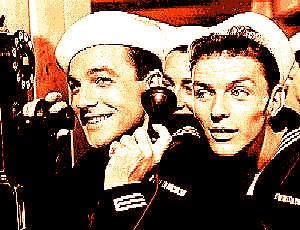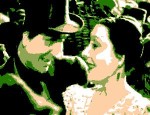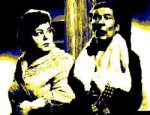Film Review
So who would win your vote for the greatest dancing duo of all
time? Fred Astaire and Ginger Rogers? Margot Fonteyn and
Rudolf Nureyev? Torvill and Dean? Surely not!
There can only be
one
recipient for such an accolade, and that has to be Gene Kelly and
Jerry Mouse (you know, the cutely sadistic little rodent from the
Tom & Jerry cartoons who
inexplicably reminds you of Captain James T. Kirk). Alas,
the only surviving record of Gene and Jerry's legendary partnership is
a dance sequence in an exuberant Hollywood musical entitled
Anchors Aweigh (not to be confused
with
Bankers Away, a popular
fantasy of circa 2009 in which every financier on the planet was slowly
roasted on a spit over a fire fuelled by the banknotes that made up his
last Christmas bonus).
Have corporeal man and animated beast ever performed together with such
impeccable style and panache? History does not report how Gene
and Jerry first got together or how their association ended, but we
suspect that naughty feline Tom had something to do with it. Or
may be it was Frank Sinatra?
This was the first time that Sinatra and Kelly appeared together and,
presumably on the back of the latter's bust up with Jerry, they would
work together on two more popular film musicals, including the 1949 hit
On
the Town. Ol' Blue Eyes may lack Jerry's youthful
vigour and unbeatable dancing prowess, but he wins hands down in the
singing department. Sinatra's soul-wrenching rendition of
I Fell in Love Too Easily is easily
one of the film's highlights, and the song went on to become one of the
singer's most popular hit records.
Unpredictable and as stylistically varied as a bag of licorice allsorts
or the private tie collection of a TV news presenter,
Anchors Aweigh is far from being
the conventional Hollywood musical. Yet, mad as it is, it has all
the ingredients that make a musical film so enjoyable and endlessly
popular. Forget the plot - it is too contrived and implausible to
merit even a moment's consideration. Forget also the strains of
jingoism that were probably shoe-horned in at the last moment to give
the film greater appeal in the immediate aftermath of WWII (which is
when the film was released). What we should focus on is the
magical concoction of comedy, romance, song and dance that director
George Sidney so expertly orchestrates, with the help of his talented
star performers, including a very famous cartoon mouse. The cute
little kid who looks like the model for Millais' famous
Bubbles painting is none other than
Dean Stockwell, one of the few actors to have found success both as a
child and as an adult.
Incredible to think that MGM originally wanted Mickey Mouse for that
famous mixed live action-animation dance sequence! Thankfully,
Disney declined the offer whilst Hanna and Barbera were more than
willing to lend a hand, and their most famous creations. Gene
Kelly and Jerry Mouse, brought together for what is probably the most
wonderfully inspired moment of madness in the entire history of
Hollywood (all Tom Cruise films excepted, that is). You have to admire the
skill and professionalism of all concerned. It couldn't have been
easy dancing with a sexless two-dimensional cartoon
character. Still, it was presumably better than being
pursued night and day by a viciously psychopathic cat...
© James Travers 2010
The above content is owned by frenchfilms.org and must not be copied.
Film Synopsis
Returning home to a hero's welcome after WWII, navy personnel Clarence
Doolittle and Joe Brady can hardly wait to get ashore and extract every
last morsel of pleasure from their leave. But whilst Joe has a
hot date lined up, Clarence is at a loose end and, worse, he lacks both
experience and confidence in the woman-baiting department.
Against his better judgement, Joe agrees to help his sailor buddy find
a girl. The evening does not go quite as planned, however.
Instead of painting the town red, Joe and Clarence end up playing wet
nurse to a runaway boy named Donald. Having taken the errant
scallywag home, the sailors have to wait until his guardian, Aunt
Susan, returns from her night at the opera. Donald, it
seems, is desperately keen to join the navy, but Joe convinces him that
he is too young: he must first learn to read and write. Aunt
Susan turns out to be an attractive young woman and as soon as Clarence
sets eyes on her he knows she is the woman for him. Susan, it is
revealed, works as a bit player in motion pictures, but her real
ambition is to be an opera singer. The next day, Joe and Clarence
pay Susan another visit, and succeed in scaring off a caller, mistaking
him for an unwelcome suitor. In fact the caller was someone with
the contacts who could provide Susan with her big break. Aunt
Susan is naturally upset when her one hope of starting a singing career
goes up in smoke, but Clarence comes to the rescue by telling her he
has fixed up an audition for her with José Iturbi, the great
composer and pianist. Of course, Clarence has done nothing of the
kind, but he is confident that with Joe's help he can persuade Mr
Iturbi to give a promising young talent like Susan a few minutes of his
time. Meanwhile, Joe has made a terrible discovery. He is
head over heels in love with Susan...
© James Travers
The above content is owned by frenchfilms.org and must not be copied.


